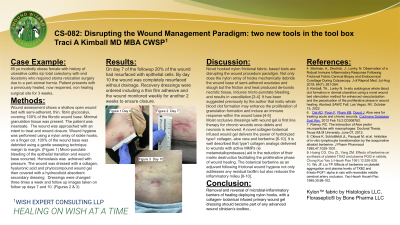Case Series/Study
(CS-082) Disrupting the Wound Management Paradigm: two new tools in the tool box

Introduction: 65 yo morbidly obese female with history of ulcerative colitis s/p total colectomy with end ileostomy who required stoma relocation surgery due to a peri-stomal hernia. Patient presents with a previously healed, now reopened, non healing surgical site for 3 weeks.
Methods: Wound assessment shows a shallow open wound bed with semi-adherent, thin, fibrin glycocalyx, covering 100% of the fibrotic wound base. Minimal granulation tissue was present.The patient was insensate.
The wound was approached with an intent to treat and wound closure. Wound hygiene was performed using a nylon array of sickle hooks, on a finger cot. 100% of the wound base was debrided using a gentle sweeping technique margin to margin. (Figure 1) Micro-punctate bleeding of the epithelial transition and wound base occurred. Hemostasis was achieved with pressure. The wound was dressed with a collagen, hyaluronic acid and phytocompound wound gel then covered with a hydrocolloid absorbent secondary dressing.
Dressings were changed three times a week and follow up images taken on follow up days 7 and 10.
Results: On day 7 of the followup 20% of the wound had resurfaced with epithelial cells. By day 10 the wound was completely resurfaced without drainage. Recovery dressings were ordered including a thin film adhesive and the wound monitored weekly for another 2 weeks to ensure closure.
Discussion: Novel hooked nylon frictional fabric- based tools are disrupting the wound procedure paradigm. Not only does the nylon array of hooks mechanically debride the wound base of semi-adhered exudates and slough but the friction and heat produced de-bonds necrotic tissue, induces
micro-punctate bleeding, and results in vasodilation.[3-4] It has been suggested previously by the author that insitu whole blood clot formation may enhance the proliferation of granulation formation and induce an immune response within the wound base.
Moist occlusive dressings with wound gel is first line therapy for chronic wounds once debris and necrosis is removed. A novel collagen-botanical infused wound gel delivers the power of hydrolyzed type1 collagen, aloe vera and berberine. It is well described that type1 collagen analogs delivered to wounds with active MMPs (ie metametalloproteases) aid in the reduction of their matrix destruction facilitating the proliferative phase of wound healing. The botanical berberine as an adjuvant following frictional wound hygiene not only addresses any residual biofilm but also reduces the inflammatory milieu
Trademarked Items: Kylon fabric by Histologics Floraseptic by Bone Pharma LLC
References:
Methods: Wound assessment shows a shallow open wound bed with semi-adherent, thin, fibrin glycocalyx, covering 100% of the fibrotic wound base. Minimal granulation tissue was present.The patient was insensate.
The wound was approached with an intent to treat and wound closure. Wound hygiene was performed using a nylon array of sickle hooks, on a finger cot. 100% of the wound base was debrided using a gentle sweeping technique margin to margin. (Figure 1) Micro-punctate bleeding of the epithelial transition and wound base occurred. Hemostasis was achieved with pressure. The wound was dressed with a collagen, hyaluronic acid and phytocompound wound gel then covered with a hydrocolloid absorbent secondary dressing.
Dressings were changed three times a week and follow up images taken on follow up days 7 and 10.
Results: On day 7 of the followup 20% of the wound had resurfaced with epithelial cells. By day 10 the wound was completely resurfaced without drainage. Recovery dressings were ordered including a thin film adhesive and the wound monitored weekly for another 2 weeks to ensure closure.
Discussion: Novel hooked nylon frictional fabric- based tools are disrupting the wound procedure paradigm. Not only does the nylon array of hooks mechanically debride the wound base of semi-adhered exudates and slough but the friction and heat produced de-bonds necrotic tissue, induces
micro-punctate bleeding, and results in vasodilation.[3-4] It has been suggested previously by the author that insitu whole blood clot formation may enhance the proliferation of granulation formation and induce an immune response within the wound base.
Moist occlusive dressings with wound gel is first line therapy for chronic wounds once debris and necrosis is removed. A novel collagen-botanical infused wound gel delivers the power of hydrolyzed type1 collagen, aloe vera and berberine. It is well described that type1 collagen analogs delivered to wounds with active MMPs (ie metametalloproteases) aid in the reduction of their matrix destruction facilitating the proliferative phase of wound healing. The botanical berberine as an adjuvant following frictional wound hygiene not only addresses any residual biofilm but also reduces the inflammatory milieu
Trademarked Items: Kylon fabric by Histologics Floraseptic by Bone Pharma LLC
References:

.png)
